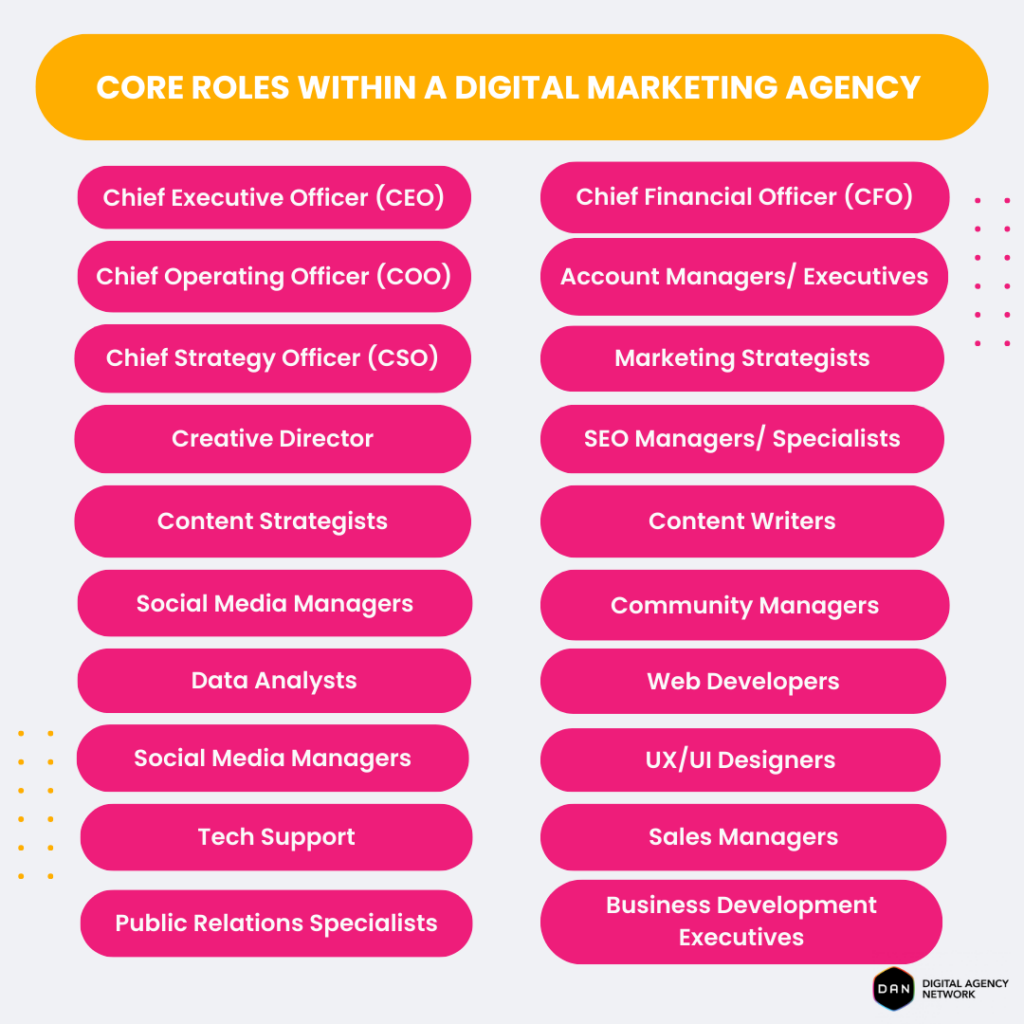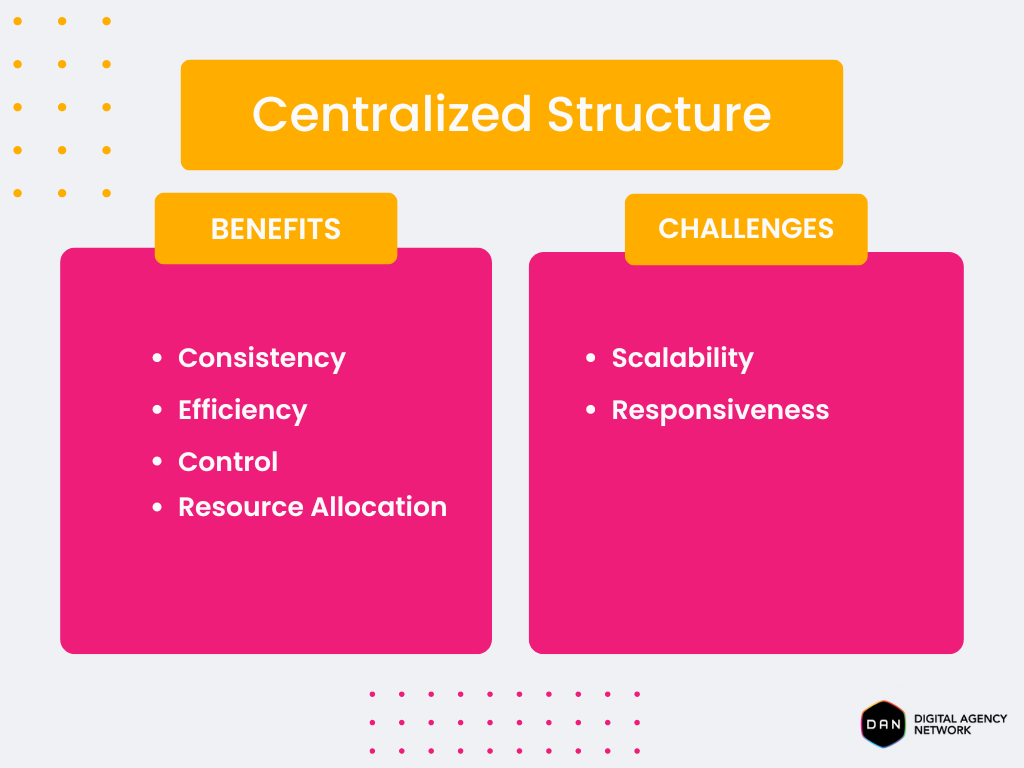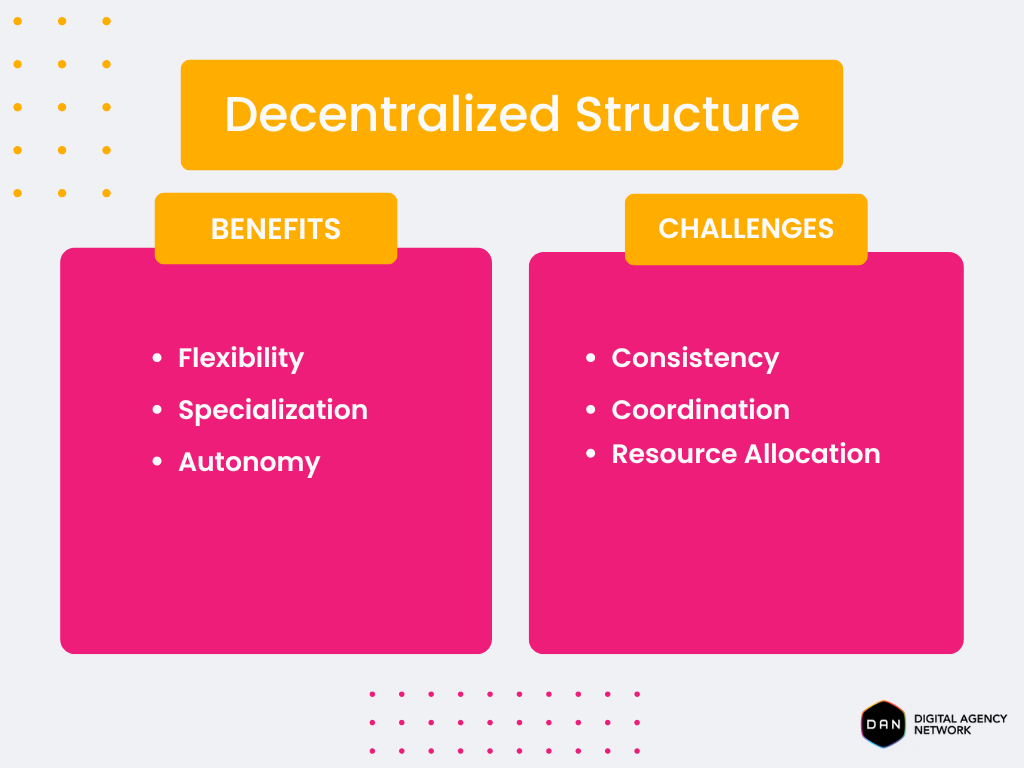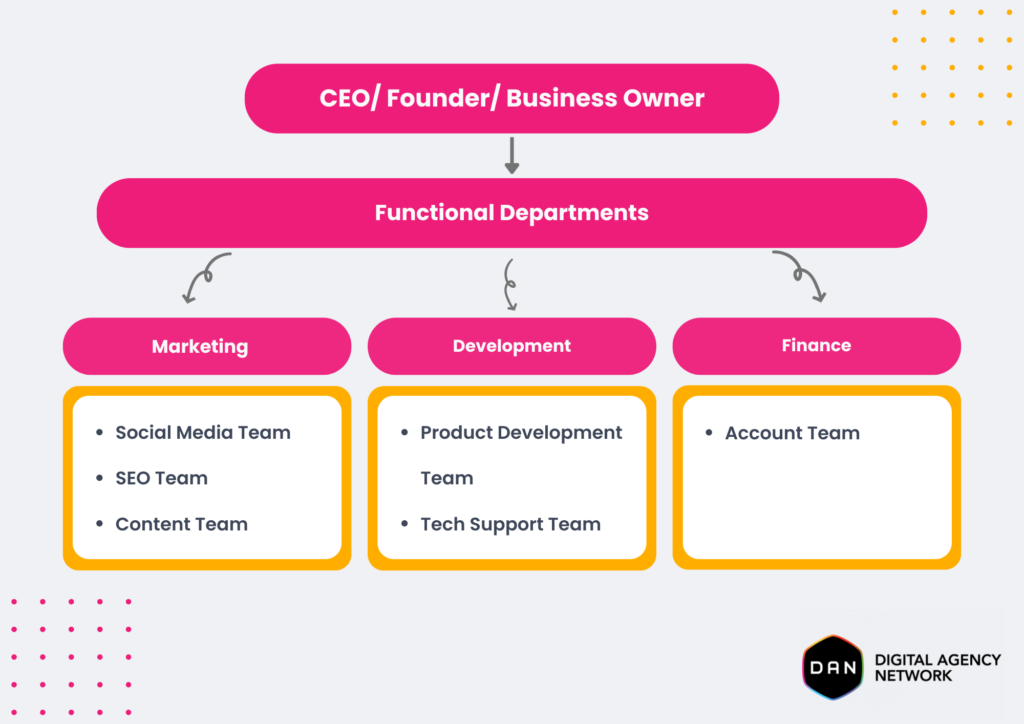
How to Build The Best Digital Marketing Agency Team Structure In 2024?
Digital marketing is perceived to be an easy business, considering that real work is done online. However, many agency owners overlook the importance of the marketing agency team structure that will make the work happen.
In an ideal scenario, you will invest an equal amount of time and energy in formulating a team that carries out online marketing tasks in the right way.
While formulating the digital marketing agency team structure, you need to list down ideal team positions. In a small agency, one person might be taking care of multiple roles like a department in themselves, but it is better to divide work equally and separately, so the future mishaps can be avoided.
Your goal should be to become a digital marketing agency with a flexible, agile working environment.
We’ve prepared this guide to help you understand the key components of a digital marketing agency organizational structure, and how to build a team that excels. Remember, as digital marketing strategies evolve, so must the teams that implement them.
What is a Digital Marketing Team
A group of professionals with skills and expertise in different aspects of digital marketing brings together the digital marketing team. These experts work together to plan, execute, and optimize online marketing efforts and campaigns. The digital marketing agency structure typically includes roles in content creation, SEO, social media, paid advertising and analytics. If you’re trying to build a cohesive and effective team, you need to understand the digital marketing organization structure for the success of your agency.
Core Roles Within a Digital Marketing Team Structure
The digital marketing agency organizational chart may differ from agency to agency, but the following roles are considered the backbone of a digital marketing agency team structure. This list may guide you when starting a digital marketing agency of your own:

- Chief Executive Officer (CEO): Leads overall strategy and vision.
- Chief Operating Officer (COO): Manages daily operations.
- Chief Financial Officer (CFO): Oversees financial planning and budgeting.
- Account Managers/ Executives/ Specialists: Liaise with clients and manage projects, support managers with client communication and coordination.
- Chief Strategy Officer (CSO): Develops overall marketing strategies.
- Marketing Strategists: Conduct market research and strategy development.
- Creative Director: Guides creative vision.
- Graphic Designers: Design visual content.
- SEO Managers/ Specialists: Optimize content for search engines.
- Content Strategists: Plan content marketing strategies.
- Content Writers: Write engaging articles and posts.
- Social Media Managers: Develop and implement social media strategies.
- Community Managers: Foster audience engagement.
- Social Media Analysts: Monitor and analyze social media metrics.
- PPC Media Specialists: Manage pay-per-click campaigns.
- Data Analysts: Analyze marketing data.
- Data Scientists: Use data modeling to predict trends.
- Web Developers: Build and maintain websites.
- UX/UI Designers: Enhance user experience and design interfaces.
- Tech Support: Provide technical assistance.
- Public Relations Specialists: Manage public image and media relations.
- Sales Managers: Lead the sales team and strategies.
- Business Development Executives: Identify new business opportunities.
- Growth Marketers: hacks experiments and data to fuel user acquisition, retention, and business growth.
Executive Department
Chief Executive Officer/ Founder (CEO): The CEO is basically the captain of the ship at a digital marketing agency. They’re the one who charts the course, figuring out where the agency is going and how to get there. They call the big shots to make sure everything the agency does lines up with that grand vision. In short, the CEO is a super important role, shaping the agency’s future and steering it towards growth.
Chief Operating Officer (COO): make sure the day-to-day stuff runs like clockwork, keeping everything efficient and on track. That means overseeing projects from start to finish, making sure everyone has the resources they need, and keeping things running at a top-notch level.
Chief Financial Officer (CFO): The CFO handles all financial aspects – financial planning, budgeting, and reporting. Basically, they keep the agency healthy by watching costs, finding ways to bring in more revenue.
Account Department
Account Managers: Imagine the account manager as your go-to person at the agency. They’re the ones clients chat with the most, building friendships and figuring out what the client needs. They make sure projects get done on time, keeping everyone happy. Basically, they’re the client champions, ensuring they’re satisfied and wanting to work with the agency again and again.
Account Executives: Account executives are basically the account manager’s trusty sidekick. They handle the day-to-day stuff, keeping things running smoothly by communicating with clients, coordinating projects, and making sure everything stays on track.
Finance Department
One of the most important parts of an agency is the finance department. People at the account services will also be in charge of making sure that the client is billed and reminded to transfer payments.
They take care of everything related to money because money is what you want to make in your agency! That’s why it is crucial to hire a good accounting team who can tell you that a payment is delayed without making it sound like it is your fault.
The department is responsible for paying salaries, benefits, vendor bills, daily business costs, travel costs and any other costs that arise. Once again, it can be a single person or a team of multiple managers working on different sections as a team.
Strategy Department
Chief Strategy Officer (CSO): The Chief Strategy Officer (CSO) is the agency’s master strategist. They use their market smarts and client know-how to build winning marketing plans that get results. By diving deep into market trends and getting a clear picture of the client’s goals, the CSO plays a key role in charting the course for all marketing efforts within the agency.
Marketing Strategists: Marketing Strategists analyze market trends, conduct research, and create tailored marketing strategies for clients. They ensure that all marketing initiatives are data-driven and aligned with client objectives.
SEO and Content Team
SEO Specialists: SEO Specialists optimize websites to improve search engine rankings and drive organic traffic. Their expertise in search algorithms and keyword strategies is crucial in the digital marketing agency organizational chart.
Content Strategists: Content Strategists plan and oversee content strategies to engage and attract the target audience. They ensure the content aligns with the client’s business goals and is optimized for search engines.
Content Writers: Content Writers create informative and engaging blog posts tailored to the client’s industry and audience. Their ability to craft compelling narratives is essential for the company’s overall brand reputation.
Creative Department
There are many different roles within the creative department, but the most common ones are as follows:
• Designers
• Production managers
• Art directors
• Creative directors
These roles are grown out of the need of the hour, and many of these people are paired up to work as a team on a project. Generally, everyone in the creative services department reports to the creative director.
Creative Director: The Creative Director oversees the creative vision, ensuring all content aligns with the client’s brand. This role includes leading the creative team and maintaining consistency across all visual content. In the digital agency organizational structure, the Creative Director is essential for delivering compelling and cohesive creative work.
Graphic Designers: Graphic Designers create visual content such as logos, statistical infographics, and social media graphics. Their work enhances the visual appeal and effectiveness of marketing campaigns, making them integral to the digital marketing agency structure.
Production Managers: Production Managers oversee the entire production process, ensuring that projects are completed on time and within budget. They coordinate with different departments to manage workflow, allocate resources, and solve any issues that arise during the production phase. Their role is crucial in maintaining the quality and efficiency of the creative output, making them indispensable in the digital marketing agency team structure.
Art Directors: People who work as Art Directors manage the artistic aspects of projects, providing creative direction and guidance to the design team. They work closely with both the creative director and graphic designer to develop visual concepts and ensure that all creative work meets the highest standards of quality and aligns with the client’s brand identity.
Social Media Department
Social Media Managers: Social Media Managers develop and implement social media strategies across various platforms. They engage with audiences, manage social content, and monitor performance metrics.
Community Managers: Community Managers chat with the audience, respond to comments, and create a welcoming vibe. They help build and keep strong relationships with the audience, which is key to the digital agency’s team structure.
Social Media Analysts: Social Media Analysts monitor social media metrics, analyze performance, and adjust strategies as needed. Their insights help optimize social media efforts, making them essential in the digital marketing agency org chart.
Paid Media Department
PPC Specialists: PPC Specialists take charge of pay-per-click campaigns on platforms like Google Ads and social media. Their skills in managing ad budgets and maximizing returns are essential for the digital marketing agency’s success.
Media Buyers: Media Buyers secure advertising space and time across different platforms to boost reach and ROI. They ensure ads are placed where they’ll have the most impact.
Campaign Managers: Campaign Managers handle the execution of paid ad campaigns, making sure they hit performance targets. An important role for coordinating and managing successful ad campaigns within the digital marketing agency.
Analytics and Data Team
Data Analysts: Data Analysts collect and analyze data to measure the effectiveness of marketing campaigns. They provide actionable insights that inform strategy, making them integral to the digital marketing agency organizational structure.
Technology and Development Department
Web Developers: Web Developers create and maintain websites, making sure they work smoothly, are user-friendly, and perform well.
UX/UI Designers: UX/UI Designers concentrate on user experience and interface design to craft engaging and intuitive digital products. Their work enhances usability and customer satisfaction.
Tech Support: Tech Support helps out with technical issues and sorts out problems with digital marketing tools and platforms.
PR and Communications Department
Public Relations Specialists: Public Relations Specialists handle the public image of the agency and its clients, manage media relations, and write press releases. Their work ensures positive media coverage and a strong brand reputation.
Communication Managers: Communication Managers create and execute communication strategies both inside and outside the agency. They ensure messaging is consistent and communication is effective.
Sales and Business Development Department
Sales Managers: Sales Managers lead the sales team, develop sales strategies, and manage client acquisition. Their leadership drives revenue growth and client relationships within the digital marketing agency structure.
Business Development Executives: Business Development Executive position is predicted to have the largest employment gains until 2027. People who work in this position identify new business opportunities and build relationships with potential clients. Their efforts expand the agency’s reach and capabilities, playing a strategic role in the digital marketing agency organizational chart.
Digital Marketing Team Structure: Centralized vs. Decentralized
When deciding on your digital marketing agency organizational chart, you must consider whether a centralized or decentralized structure best suits your needs. Each structure has its unique benefits and challenges, and understanding them will help you make an informed decision.
Centralized Structure
In a centralized model, all marketing efforts are managed by a core team. This approach ensures consistent messaging and strategy across all channels. It’s ideal for smaller agencies or those with a unified brand message. The benefits of a centralized structure include:
- Consistency: With a single team overseeing all marketing activities, it’s easier to maintain a consistent brand voice and strategy.
- Efficiency: A centralized team can streamline processes and reduce redundancies, leading to more efficient operations.
- Control: Agency leaders have greater control over the direction and execution of marketing campaigns, ensuring alignment with overall business goals.
- Resource Allocation: Resources can be allocated more effectively, focusing on high-priority projects without duplication of efforts.

However, a centralized structure also has its challenges:
- Scalability: As the agency grows, a centralized team might struggle to manage an increasing number of projects and clients.
- Responsiveness: This model can be less responsive to market changes and client needs, as decision-making and execution might be slower.
Decentralized Structure
In a decentralized model, different teams or departments manage their own marketing efforts. This structure allows for more flexibility and responsiveness but requires strong communication and coordination to maintain consistency. The benefits of a decentralized structure include:

- Flexibility: Teams can quickly adapt to market changes and client demands, providing more customized and timely solutions.
- Specialization: Different teams can focus on specific areas of expertise, leading to higher quality and more innovative outcomes.
- Autonomy: Teams have the autonomy to make decisions and implement strategies that best suit their specific goals and contexts.
However, a decentralized structure comes with its own set of challenges:
- Consistency: Maintaining a consistent brand voice and strategy across different teams can be difficult without strong communication and coordination.
- Coordination: Effective coordination between teams is essential to avoid duplication of efforts and ensure alignment with overall business goals.
- Resource Allocation: Resources may be spread thin across multiple teams, leading to potential inefficiencies and resource management challenges.
When choosing between a centralized and decentralized structure, consider factors such as the size of your agency, the complexity of your projects, and your overall business goals. For smaller agencies or those with a strong, unified brand message, a centralized structure may be more effective. In contrast, larger agencies or those with diverse services and markets might benefit from the flexibility of a decentralized structure.
Ultimately, the key to success lies in balancing control and consistency with flexibility and responsiveness. Regularly assess your organizational structure and make adjustments as needed to ensure your team can effectively execute your digital marketing strategies.

Team Structures by Digital Marketing Company Size
The process of starting, running, and organizing a digital marketing agency doesn’t have a standard structure. The most logical answer is that it depends.
It depends on the size of your business, the business location, the nature of your business, key business solutions and also on the kind of people who are responsible for running the departments for your business.
- Small Companies: For small companies, a lean digital marketing agency structure is often necessary. Roles are often multifunctional, with employees wearing multiple hats or outsourcing certain functions.
- Medium-Sized Companies: Mid-sized companies benefit from a more specialized digital marketing team structure. This setup typically includes dedicated roles for content, SEO, social media, and paid advertising, creating a balanced and effective team.
- Large Companies (MNCs): Large multinational corporations require a complex digital agency organizational structure. This includes specialized teams for different regions, products, or services, ensuring comprehensive coverage and expertise.
Conclusion
Understanding the many departments and tasks that comprise an efficient team is important for creating the ideal digital marketing agency team structure in 2024. Make sure that your team is well-coordinated and in line with your business objectives regardless of the type of organization structure you choose for your digital marketing—centralized or decentralized.
Assess your current marketing agency structure, make the required changes, and watch as your digital marketing strategies succeed.




















